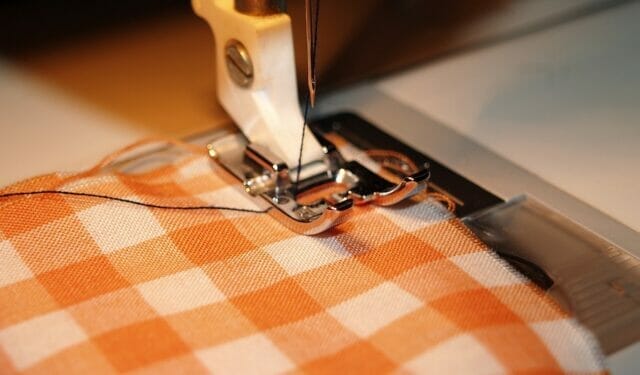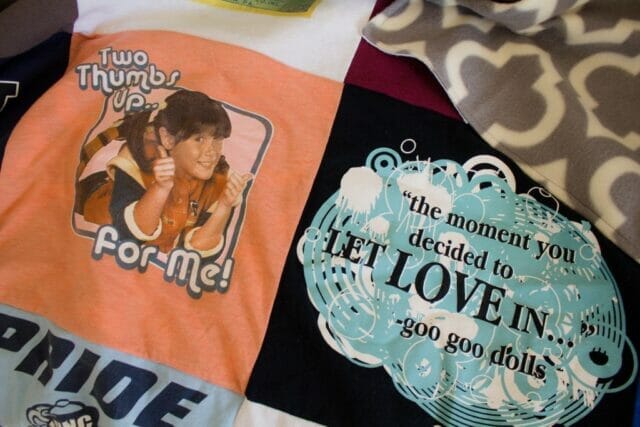
Being a careful, eco-conscious shopper is beneficial for the planet. Buying clothes made from sustainable materials or simply shopping less is far more ethical than filling your closet with unnecessary purchases.
Studies have shown the fashion industry produces up to 10% of greenhouse gas emissions and will likely fail to meet the 2030 emissions target set by the Paris Agreement if something doesn’t change.
Let’s say you’ve recently gone through your closet and pulled out several old worn and torn garments. Maybe you have some that don’t fit anymore or still have the tags attached. Go through the pile again and begin thinking about how you might upcycle them and extend their use. Here are 10 ways you might repair or repurpose worn-out clothes.
- For clothes that are not worn out and still have life, see Eco-Stylist’s Guide for more ideas like selling and swapping.
- For old clothes that you want to recycle (not upcycle), check out the section “Recycle” in the same guide.
How to Repair Your Old Clothes

Some worn out clothes deserve a second chance. Can you make the repairs yourself? Do you need the help of a tailor? Here’s some ideas.
1) Remove Tough Stains to Keep Old Clothes in Use
We all have that favorite shirt that’s a magnet for spills and stains. After some time, you might want to toss it. After all, how many times can you launder it before it’s unwearable?
Before throwing away half your wardrobe, consider trying some home remedies to remove stains in your clothes. Common stains may include adhesives, wine, makeup, oil, and sweat. Yet, each type of stain may work better with a different removal trick.
For example, it’s helpful to stick your clothing in the freezer for 30 minutes to harden and scrape gum stains off. For fruit stains, such as watermelon juice, it’s important to wash the piece of clothing in the hottest water possible immediately (or as soon as possible).
2) Sew Patches to Repair Tears

Although ripped jeans are a hot fashion trend at the moment, the style is not for everyone. If you have rips and tears in your clothes, consider sewing patches to create an entirely new look. Better yet, use other worn garments to make the patches.
Perhaps you came across an old shirt with an interesting pattern or color. Cut a square out and sew it over the rip in your jeans.
You might also do this with torn t-shirts, purses, or other fabrics that need a minor repair. Sewing patches allows you to save one piece of clothing with another piece of clothing.
Upcycling or Repurposing Your Old Clothes
Sometimes repairing isn’t a great option. Luckily there are many ways to upcycle your worn out threads into something new and useful!
3) Repurpose Old Clothes Into Makeup Remover Pads
A worn, soft cotton t-shirt could find new life as a makeup remover pad. Cut part of your t-shirt into a rectangular shape, fold it in half, and sew along its edges to make a washcloth.
These handmade makeup remover pads don’t have to be exact, as long as the stitching is durable enough to not come apart in the washing machine.
When you finish using them a couple of times to remove the day’s makeup, throw them in with your next load of laundry and use them again. This will also help you avoid makeup wipes or other single-use items.
4) Upcycle Clothing into Reusable Food Coverings

According to the U.S. Food and Drug Administration, about 31% of food loss occurs at grocery stores and with the consumer. It’s easy to overbuy food, and many times we may not get around to eating it before it goes bad.
Before you get rid of your worn-out clothes, could you possibly reuse them as food coverings to prevent spoilage?
Set your oven to 200°F, cut a piece of fabric to your liking, and place it on a parchment paper-lined sheet pan. Sprinkle beeswax pellets over the material and warm it up in the oven for 4-8 minutes.
When the beeswax pellets are melted, smooth them over the fabric with a paintbrush. Allow the fabric to dry and then use it to wrap your sandwich or over a container to keep food and leftovers fresh.
5) Repurpose Old Clothing into a T-Shirt Blanket

T-shirt enthusiasts may find it difficult to part with their collection. Whether you’ve purchased tees while vacationing or frequently attend concerts, you’ve likely attached happy memories to specific items.
Rather than throw them away, consider creating a t-shirt blanket to preserve the good times and have a keepsake for years to come. This is also an excellent project for those who’ve lost a loved one and want to keep some of their personal items.
If a DIY t-shirt blanket is out of the question, many services are available to create one for you.
6) Transform Worn Clothing to Make Hair Headbands
You’ll probably want something to push your hair out of your face during the hot summer months. A t-shirt headband is an easy craft you can do to repurpose your old t-shirts.
There are many ways you can make a headband with worn-out fabric. It’s also a relatively quick project to transform something old into something new that’s fun to wear.
You might decide to use a shirt that has a pattern or two different colored shirts for a two-tone headband. The best part is that you can throw them in the laundry if they get a bit sweaty.
7) Upcycle Old Jeans Into Shorts for Summer
Blue jeans are a fashion staple globally; however, they’re also a major environmental offender. Denim is primarily made from cotton. It takes about 7,660 gallons of water to produce 2.2 pounds of the stuff.
If you own ratty, worn-out blue jeans, you might think twice before getting rid of them. Instead, repurpose them into summer shorts or capris. Decide what length you’d like them to be and make the cut.
You may choose to sew them for a clean edge or give them a bit of visual interest with some fringe.
8) Make an Upcycled T-Shirt Produce Bag

Here’s a shocking number: if one person opted for reusable bags over their lifetime, they’d prevent 22,000 bags from polluting the environment.
If you want to be the person who stops plastic pollution in its tracks, you should think about transforming your old clothes into produce bags.
Grocery stores usually offer plastic bags to carry your fruits and vegetables to the checkout. However, you can make a knit produce bag from a t-shirt without the need for extra plastic. Grab some old t-shirts, a sewing machine, and scissors for this easy project.
9) Sew a Plush Toy With Baby Clothes
Babies tend to grow out of their clothes rather quickly. If you’re left with your little one’s wardrobe, you might upcycle their clothes into a plush toy they can snuggle with.
There are many unique designs for making bespoke stuffed creatures, and you could even create an entire collection.
When your child grows up, holding onto their handmade plush toy will be a beautiful keepsake they can hand down to their own kids someday, or an excellent way to look back on their childhood and hold a piece of their baby clothing.
10) Make a Tote Bag With Worn Men’s Shirts
T-shirts are not the only option for making a new bag. Men’s dress shirts can also be repurposed into tote bags with the added convenience of the pocket on the outside.
If you have kids, tote bags are perfect for them to pack books or toys for a car ride or vacation. Rather than buying a new bag, make your kid something special using their dad’s old shirt. It will be practical, sentimental and eco-friendly.
Endless Ways to Upcycle and Repurpose Your Old Clothes
Of course, these 10 upcycling ideas are only a few different ways you might repair or repurpose your old clothes. The possibilities are never-ending for fun, eco-friendly clothing projects for you to do. Let your creativity flow as you extend your clothing’s lifespan in a fresh, new way.
Your Guide to a Sustainable Closet
For additional reading, here’s a few more resources you may find helpful for taking care of your clothes, extending their life, and the most eco-friendly options for clothes and shoes you may no longer want.
- 6 Sustainable Ways to Get Rid of Old Clothes and Shoes
- Zero Waste Hacks for Doing Your Laundry
- Three Things You Can Do To Reduce Microplastic Pollution
This is a guest post written by Cora Gold.

Author Bio: Cora Gold is the Editor-in-Chief of women’s lifestyle magazine Revivalist. She has a passion for living a happy, healthy and sustainable life and sharing inspiration with others through her writing.









